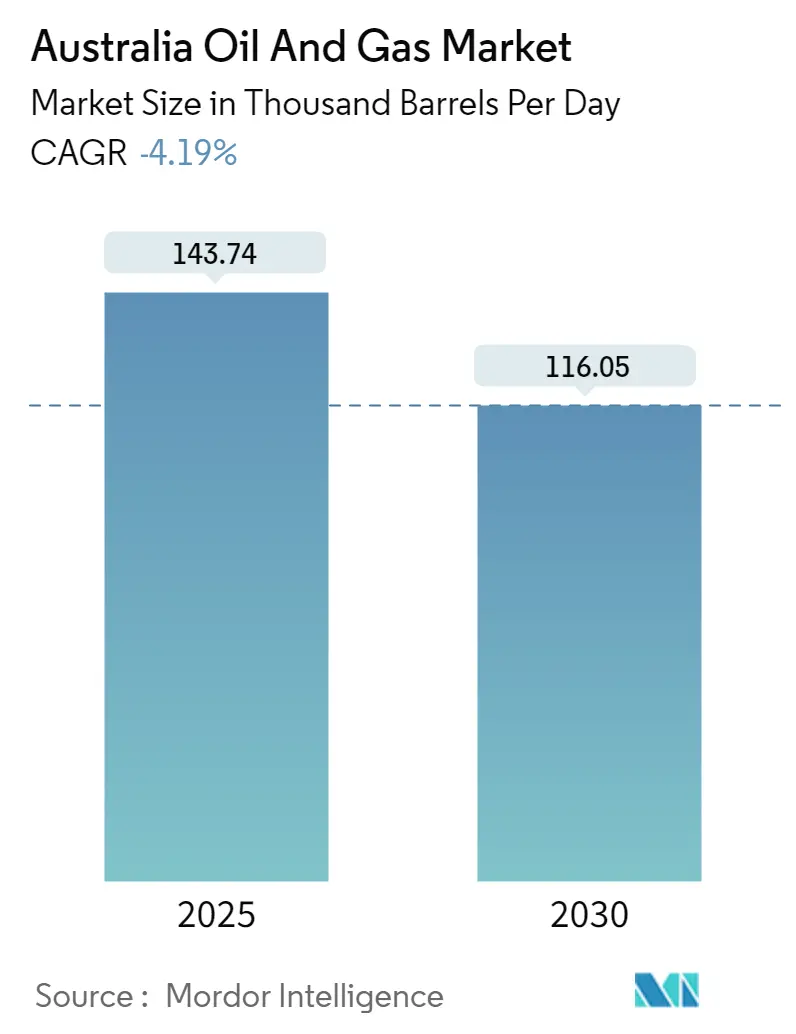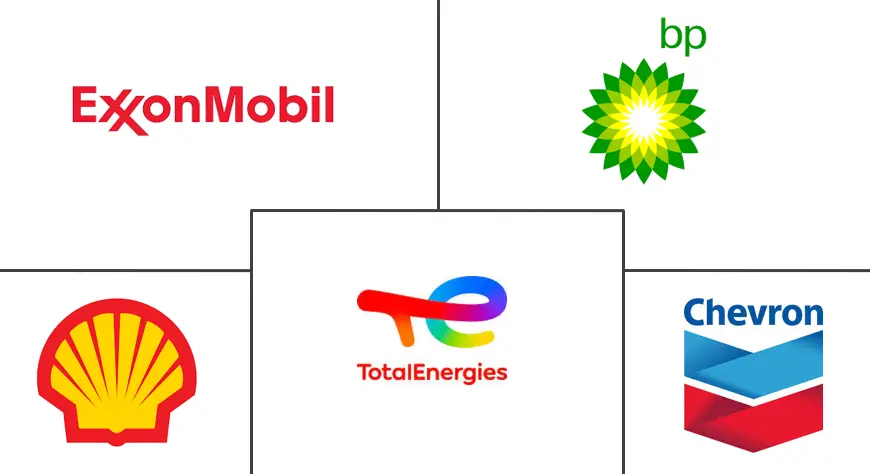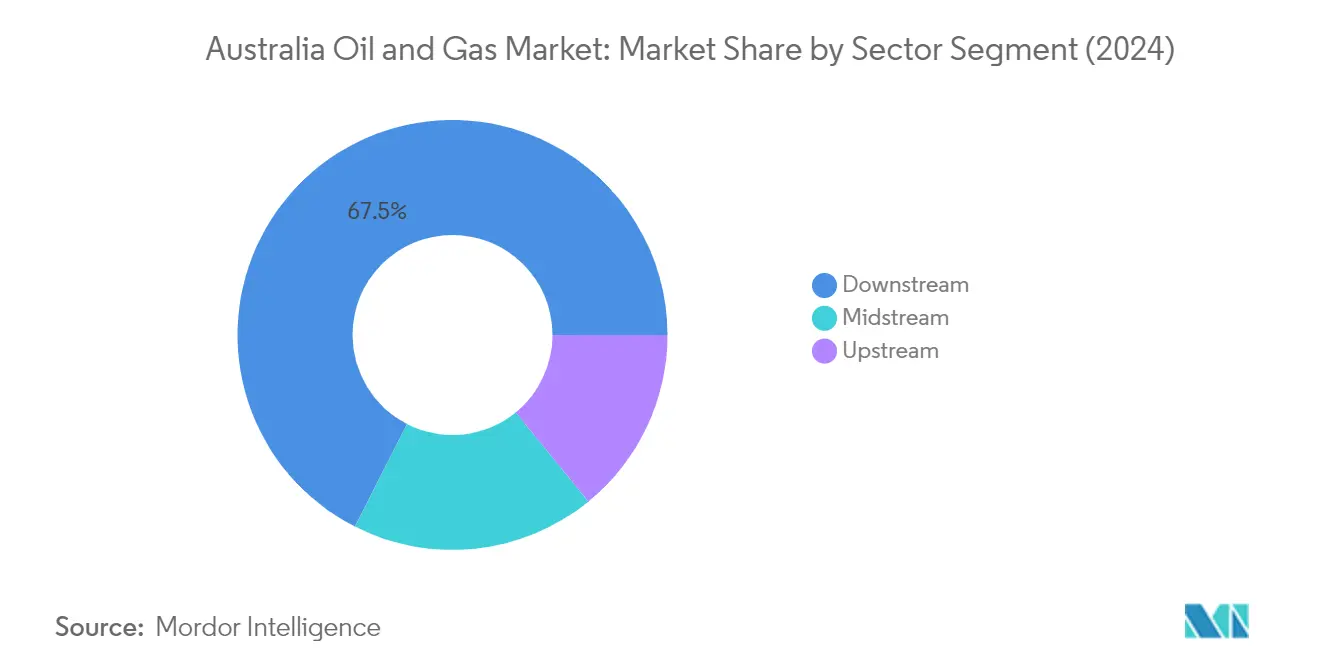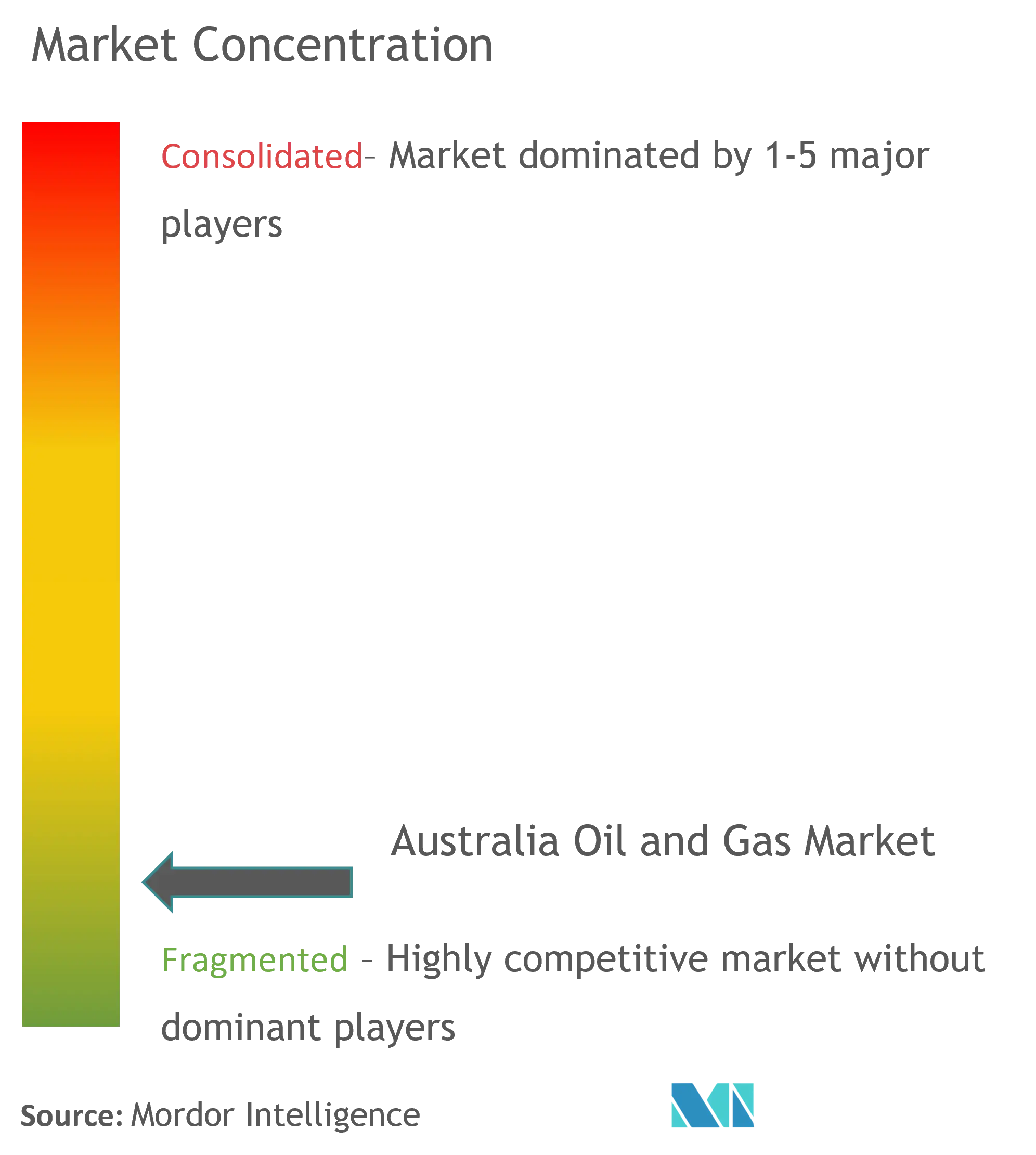
| Study Period | 2020 - 2030 |
| Base Year For Estimation | 2024 |
| Forecast Data Period | 2025 - 2030 |
| Market Volume (2025) | 143.74 Thousand barrels per day |
| Market Volume (2030) | 116.05 Thousand barrels per day |
| CAGR | -4.19 % |
| Market Concentration | Medium |
Major Players
*Disclaimer: Major Players sorted in no particular order |
Australia Oil and Gas Market Analysis
The Australia Oil And Gas Market size is estimated at 143.74 thousand barrels per day in 2025, and is expected to decline to 116.05 thousand barrels per day by 2030.
Australia has established itself as a dominant force in the global liquefied natural gas (LNG) market, maintaining its position as one of the world's leading exporters. The country's strategic geographical location and substantial gas reserves have enabled it to meet growing energy demands across the Asia-Pacific region. Natural gas production has shown consistent growth, with forecasts indicating an increase to 16.79 billion cubic feet per day by 2026, reflecting the industry's robust expansion plans. The country's LNG infrastructure continues to evolve, with multiple export terminals operating at full capacity and new projects under development to maintain its competitive edge in the global oil and gas industry.
The upstream sector has undergone significant transformation through strategic consolidation and operational optimization. In August 2021, the oil and gas industry witnessed a landmark merger between BHP Group and Woodside Petroleum, creating an AUD 41 billion (USD 29.8 billion) energy powerhouse, followed by the merger of Santos Ltd and Oil Search Ltd to form Australia's largest upstream producer. These consolidations have strengthened the sector's operational capabilities and financial resilience, enabling more efficient resource development and exploitation. The industry has also seen renewed interest in exploration activities, particularly in the Carnarvon and Browse basins.
The downstream sector has experienced substantial restructuring, marked by a significant reduction in refining capacity from 457,000 barrels per day to 229,000 barrels per day. This transformation reflects the oil and gas sector's adaptation to changing market dynamics and economic pressures. The Australian government has responded by implementing a comprehensive fuel security package worth USD 3.7 billion, focusing on minimum stockholding requirements and infrastructure support. These measures aim to ensure domestic fuel security while supporting the transition of existing facilities to import terminals.
The Australia oil and gas industry is increasingly embracing technological advancement and digital transformation across its operations. Oil and gas companies are implementing artificial intelligence, machine learning, and automation solutions to optimize production processes and enhance operational efficiency. The sector has seen significant investment in digital infrastructure, with major players developing integrated digital platforms for real-time monitoring and decision-making. These technological initiatives are complemented by the development of new gas processing facilities and pipeline infrastructure, with multiple projects under development to strengthen the domestic gas network and export capabilities.
Australia Oil and Gas Market Trends
Growing Natural Gas Production and Infrastructure Development
Australia's robust natural gas production growth has been a significant driver for the oil and gas market, supported by substantial oil and gas infrastructure development initiatives. The country has witnessed remarkable expansion in its oil and gas production capabilities, reaching 163,360 million cubic meters in 2022, demonstrating the sector's strong fundamentals and growth potential. This increased production has necessitated the development of extensive pipeline infrastructure, with Australia maintaining over 4,000 km of natural gas transmission pipelines that efficiently transport gas under high pressure from production sites to urban centers. The government's commitment to expanding infrastructure is evident through major projects such as the 580-kilometer pipeline construction in Western Australia, launched in 2022 with an investment of USD 460 million, designed to transport natural gas from the Perth Basin to resource projects in the state's Goldfields.
The Australian government's gas-fired recovery initiative has emerged as a crucial catalyst for market development, focusing on three key strategic areas: unlocking supply, delivering an efficient pipeline and transportation market, and empowering gas customers. This comprehensive approach has stimulated investments in gas infrastructure, particularly in the east coast gas market, where the entire supply chain is being enhanced to meet growing demand. The initiative has attracted significant private sector participation, as exemplified by Santos Ltd.'s strategic acquisition of a company owning an approved underground pipeline route for gas transportation from its planned Narrabri project, demonstrating the industry's confidence in the market's growth potential.
Increasing LNG Export Capabilities and Infrastructure
Australia's position as a leading global LNG exporter has driven substantial investments in LNG infrastructure and related facilities, with the country achieving impressive export volumes of 180.96 million megaliters in 2022. This strong export performance has necessitated continuous development of sophisticated LNG terminals, processing stations, and storage facilities to maintain efficient operations and meet international demand from key markets including Japan, China, South Korea, Taiwan, and Malaysia. The expansion of export capabilities has led to the development of integrated infrastructure networks, including specialized LNG processing facilities, storage terminals, and transportation systems, creating a robust foundation for sustained market growth.
The midstream sector has experienced significant expansion to support these export capabilities, with investments focusing on developing comprehensive transportation and storage solutions for crude oil, natural gas, and refined products. The sector's growth is characterized by the development of sophisticated infrastructure networks, including tanker facilities for interregional water routes and extensive pipeline systems for domestic distribution. This infrastructure development has been crucial in enabling efficient movement of products from production facilities to temporary storage plants and large storage hubs for refining, ultimately supporting the distribution of end products such as LPG, jet fuel, gasoline, and diesel to various end-users including the residential sector, industrial users, and gas stations.
Segment Analysis: By Sector
Downstream Segment in Australia Oil and Gas Market
The downstream segment dominates the Australian oil and gas sector, accounting for approximately 68% oil and gas market share in 2024. This segment encompasses refineries, petrochemical plants, and retail distribution networks across the country. Despite the closure of some refineries like BP's Kwinana facility, the Australian government has implemented significant support measures, including a USD 3.7 billion fuel security package to maintain domestic refining capabilities. The remaining operational refineries, including Lytton (owned by Ampol) and Geelong (owned by Viva Energy), have received government backing of up to USD 1.8 billion through 2030 to ensure continued operations and fuel security. The downstream sector also maintains a robust retail network with companies like Chevron Australia Downstream operating over 360 retail locations and managing multiple depots and seaboard import terminals.

Midstream Segment in Australia Oil and Gas Market
The midstream segment is experiencing rapid growth in the Australian market for the period 2024-2029, driven by extensive investments in LNG infrastructure and pipeline networks. Australia has established itself as a global leader in LNG exports with over 39,000 kilometers of natural gas transmission pipelines. Major projects like the Amadeus Basin-Moomba gas pipeline (950 kilometers) and the Queensland Hunter Gas Pipeline (825 kilometers) are enhancing the transportation infrastructure. The sector is further bolstered by the development of new LNG import terminals, with five import terminal projects currently under study using FSRU schemes. The Australian government's focus on expanding domestic storage capacity by 7-15 million barrels and implementing new pipeline projects demonstrates the strong growth trajectory of this segment.
Remaining Segments in Australia Oil and Gas Market
The upstream segment continues to play a vital role in Australia's oil and gas sector through exploration and production activities. This sector maintains significant operations in both onshore and offshore locations, with major basins including the Cooper-Eromanga, Amadeus, Carnarvon, and Bonaparte basins. The segment benefits from ongoing technological advancements in exploration techniques, enhanced recovery methods, and the development of new gas fields. Recent discoveries and government support for exploration activities, particularly in offshore areas, demonstrate the continued importance of this segment to Australia's energy security and export capabilities.
Segment Analysis: By Location
Offshore Segment in Australia Oil and Gas Market
The offshore segment dominates Australia's petroleum & gas market, accounting for approximately 88% of the country's total petroleum production in 2024. This segment's dominance is primarily attributed to the vast reserves located in major basins, including the Bonaparte, Browse, Northern Carnarvon, Otway, Sorell, and Gippsland basins. The segment benefits from significant government support through legislation like the Offshore Petroleum and Greenhouse Gas Storage Amendment Bill 2021, which strengthens the regulatory framework. Major offshore developments, including the Sasanof-1 exploration well and Beach Energy's Artisan 1 discovery in the Victorian Otway Basin, continue to bolster production capabilities. The segment's strength is further enhanced by Australia's position as a leading global LNG exporter, with most of its LNG production sourced from offshore fields.
Onshore Segment in Australia Oil and Gas Market
The onshore segment is expected to demonstrate robust growth during the forecast period 2024-2029, driven by several favorable factors. The segment is witnessing increased exploration activities, particularly in the Cooper-Eromanga, Amadeus, Canning, and Surat-Bowen basins. The growth is supported by recent discoveries like the Lockyer Deep 1 project in the Perth Basin and the lifting of conventional gas drilling bans in Victoria. The segment's expansion is further propelled by the country's shifting focus toward natural gas production, especially in regions with large untapped onshore gas reserves. Government initiatives supporting domestic gas supply and competitive bidding rounds for exploration blocks are expected to accelerate growth in this segment.
Australia Oil and Gas Industry Overview
Top Companies in Australia Oil and Gas Market
The Australian oil and gas industry is dominated by major international energy corporations alongside significant domestic players. Oil and gas companies are increasingly focusing on technological advancement, particularly in the digitalization and automation of operations, to enhance efficiency and reduce operational costs. Strategic partnerships and joint ventures have become prevalent, especially in large-scale LNG projects and exploration activities. Companies are investing heavily in developing offshore assets while simultaneously expanding their downstream capabilities. The industry has witnessed a strong trend toward sustainability initiatives and clean energy integration into existing operations. Market leaders are emphasizing portfolio optimization through strategic divestments and targeted acquisitions, particularly in high-potential basins like Carnarvon and Browse. Innovation in exploration and production technologies, especially in deep-water operations, remains a key focus area for maintaining competitive advantage.
Consolidation Reshaping Industry Competitive Dynamics
The Australian oil and gas industry exhibits a balanced mix of global energy majors and domestic operators, with international players holding significant stakes in major LNG projects and offshore developments. The market structure is characterized by strong partnerships and joint ventures, particularly in capital-intensive projects, with companies pooling resources and expertise to manage risks and costs effectively. Recent years have witnessed substantial consolidation through strategic mergers and acquisitions, notably the merger between BHP's petroleum business and Woodside, creating Australia's largest upstream group. The market also sees active participation from integrated energy companies that maintain a presence across the value chain, from exploration and production to downstream operations.
The competitive landscape is evolving with increased focus on domestic gas supply security and LNG export capabilities. Major players are strategically positioning themselves through infrastructure investments and long-term supply agreements with key Asian markets. The industry has seen significant collaboration between operators in sharing infrastructure and technical expertise, particularly in offshore developments. Market dynamics are influenced by the presence of state-owned enterprises from Asian countries, which have secured strategic stakes in Australian projects to ensure energy security for their domestic markets. The competitive environment is further shaped by the increasing importance of technological capabilities and operational efficiency in determining market position.
Innovation and Sustainability Drive Future Success
Success in the Australian oil and gas industry increasingly depends on companies' ability to embrace technological innovation and sustainable practices while maintaining operational efficiency. Market incumbents are focusing on digital transformation initiatives, including artificial intelligence, machine learning, and automation, to optimize operations and reduce costs. Companies are also investing in environmental sustainability measures and carbon reduction technologies to meet evolving regulatory requirements and stakeholder expectations. The ability to secure long-term supply contracts with Asian markets while maintaining flexible operating models has become crucial for sustainable growth. Successful players are those who can effectively balance their portfolio between domestic supply obligations and export opportunities.
New entrants and smaller players can gain market share by focusing on niche areas and leveraging technological expertise in specific segments of the value chain. Success factors include the ability to form strategic partnerships with established players, particularly in areas requiring significant capital investment. Companies must also demonstrate strong environmental stewardship and community engagement capabilities to maintain their social license to operate. The regulatory environment is becoming increasingly important, with companies needing to navigate complex environmental regulations while maintaining operational efficiency. Future success will depend on the ability to adapt to changing market conditions, including potential shifts in energy mix and evolving customer preferences for cleaner energy solutions.
Australia Oil and Gas Market Leaders
-
TotalEnergies SE
-
Chevron Corporation
-
BP PLC
-
Shell PLC
-
ExxonMobil Corporation
- *Disclaimer: Major Players sorted in no particular order

Australia Oil and Gas Market News
- September 2022: Santos Ltd. sanctioned a USD 300 million pipeline project that would create an additional connection to its Darwin liquefied natural gas facility in Northern Australia.
- March 2023: ConocoPhillips announced through its Australian subsidiary that it is planning to become the upstream operator of Australia Pacific LNG (APLNG) following the closing of EIG's transaction with Origin Energy. The company also agreed to purchase up to an additional 2.49% of the shareholding in APLNG. After this transaction, it is expected to own around 49.99% of APLNG.
Australia Oil and Gas Market Report - Table of Contents
1. INTRODUCTION
- 1.1 Scope of the Study
- 1.2 Market Definition
- 1.3 Study Assumptions
2. EXECUTIVE SUMMARY
3. RESEARCH METHODOLOGY
4. MARKET OVERVIEW
- 4.1 Introduction
- 4.2 Oil and Gas Reserves Status in Australia, 2022
- 4.3 Australia Crude Oil and Natural Gas Production Forecast, until 2028
- 4.4 Australia Refining Capacity and Forecast, until 2028
- 4.5 Oil and Gas Industry Investment Trend
- 4.6 Recent Trends and Developments
- 4.7 Government Policies and Regulations
-
4.8 Market Dynamics
- 4.8.1 Drivers
- 4.8.1.1 Increasing Natural Gas Demand
- 4.8.1.2 Rising Pipeline Network and Associated Infrastructure Development
- 4.8.2 Restraints
- 4.8.2.1 Rising Shift toward Renewable Energy
- 4.9 PESTLE Analysis
5. MARKET SEGMENTATION BY SECTOR
- 5.1 Upstream
- 5.2 Midstream
- 5.3 Downstream
6. COMPETITIVE LANDSCAPE
- 6.1 Mergers and Acquisitions, Joint Ventures, Collaborations, and Agreements
- 6.2 Strategies Adopted by Leading Players
-
6.3 Company Profiles
- 6.3.1 Shell PLC
- 6.3.2 TotalEnergies SE
- 6.3.3 Chevron Corporation
- 6.3.4 ExxonMobil Corporation
- 6.3.5 BP PLC
- 6.3.6 Woodside Petroleum Limited
- 6.3.7 BHP Group PLC
- *List Not Exhaustive
7. MARKET OPPORTUNITIES AND FUTURE TRENDS
- 7.1 Growing Digitalization in the Oil and Gas Industry
Australia Oil and Gas Industry Segmentation
Oil and natural gas markets are major industries in the energy market and play an influential role in the global economy as the world's primary fuel source. The processes and systems involved in producing and distributing oil and gas are highly complex, capital-intensive, and require state-of-the-art technology.
The Australian oil and gas market is segmented by sector into upstream, midstream, and downstream. The market sizing and forecasts have been done based on volume (thousand barrels per day).
Australia Oil and Gas Market Research FAQs
What is the current Australia Oil And Gas Market size?
In 2025, the Australia Oil And Gas Market size is expected to reach 143.74 thousand barrels per day.
Who are the key players in Australia Oil And Gas Market?
TotalEnergies SE, Chevron Corporation, BP PLC, Shell PLC and ExxonMobil Corporation are the major companies operating in the Australia Oil And Gas Market.
What years does this Australia Oil And Gas Market cover, and what was the market size in 2024?
In 2024, the Australia Oil And Gas Market size was estimated at 149.76 thousand barrels per day. The report covers the Australia Oil And Gas Market historical market size for years: 2020, 2021, 2022, 2023 and 2024. The report also forecasts the Australia Oil And Gas Market size for years: 2025, 2026, 2027, 2028, 2029 and 2030.
Our Best Selling Reports
Australia Oil And Gas Market Research
Mordor Intelligence provides a comprehensive analysis of the Australian oil and gas industry. We leverage our extensive expertise in oil and gas market analysis and consulting services. Our detailed report examines the evolving landscape of the petroleum and gas sectors. It covers major oil and gas operators in Australia and key industry developments. Available as an easy-to-read report PDF for download, our research offers in-depth insights into natural gas market dynamics, oil and gas production statistics, and crucial industry trends.
The report provides invaluable insights for stakeholders across the oil and gas sector, including gas industry companies, investors, and policymakers. We analyze upcoming oil and gas projects in Australia and evaluate oil and gas industry growth patterns. Additionally, we provide detailed assessments of Australian oil fields and Australian oil reserves. Our research encompasses oil and gas business intelligence with a particular focus on suppliers for oil and gas industry and top oil and gas companies in Australia. This enables informed decision-making and strategic planning in this dynamic market environment.




